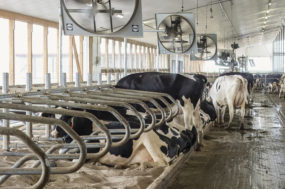In 2003, Northern Plains Dairy introduced the practice of mortality composting to Minnesota. As the first dairy in the state to dispose of dead cows via composting, it has refined and replicated the process to create the correct conditions for complete disposal of the animal. “It was done for biosecurity reasons,” says James Ailsby, operations manager at New Sweden Dairy. “They didn’t want the trucks carrying other dead animals coming onto the dairies.”
New Sweden Dairy, LLC, built a few years later in Nicollet County, Minnesota, houses more than 4,000 cows, while nearby Northern Plains Dairy, LLP, has 3,000 milking cows. Both dairies are owned by Davis Family Dairies, LLC.
Composting cow carcasses not only helps keep everything contained on the farms, but also enables the employees to deal with dead animals immediately and utilize the nutrients the carcasses can provide for fertilizer, Ailsby says. The recent change in federal rules making rendering more difficult also encourages the dairies to continue the practice.
Before it began composting, the dairy contacted the Board of Animal Health in Minnesota to seek approval for the process. Ailsby says that although this step wasn’t required by the state, it was something the dairy felt was necessary. Composting information is also included on the dairies’ environmental assessment worksheets for CAFO permits.
New Sweden replicated the composting process used at Northern Plains, and a written protocol is provided for employees responsible for that area.

According to the protocol, animals must be removed to the compost area as soon as possible after it dies or is euthanized. The ear tags and transponder collars are removed and taken to the respective dairy’s office for accurate record keeping. A check-in is also made with the herdsman to learn if the cow needs to be necropsied first.
A covered building with bays or sections is used for composting at each dairy. To fill a bay, the process starts with laying a payloader bucket full of the dairy’s feed refusals on the floor. Cows are placed two wide on top of the refusals. A knife is used to slice the cow’s abdomen, including rumen, to increase the exposed surface area for bacterial digestion of the carcass.
The carcass is then covered with a minimum 12-inch-thick layer of refusals. These provide extra nutrients to encourage proper bacterial growth.
Once a bay is full, the front is covered with a layer of sawdust to minimize odor, and the date is recorded.
At all times a layer of dry straw is maintained along the outside edge of the mortality bays to absorb any potential runoff.
To encourage the composting process, the bays are rotated every month. All material is moved from one bay to the next, except for the bay that is in the process of being filled. This helps mix in more oxygen, which speeds up the compost process.
A temperature check is also done at this time. Ideally the temperature should be 140º to 150˚F in the middle. If the temperature is too low, a moisture check is required – it should feel moist to the touch. If it is dry, water should be added. If it is wet, manure solids (from the digester at Northern Plains Dairy) should be added.

Once all contents have been moved from one bay to the next, they are covered with a 12-inch-thick layer of manure solids. The combination of feed refusals and manure solids create the right moisture levels at these dairies.
Lastly, a check is done to see that all animals, including bone fragments, are covered at all times to ensure proper composting.
Northern Plains Dairy has five bays and New Sweden has six to provide enough room for this process. Two additional bays are also available in the event an overspill area is needed.
After four to five months, the compost is ready to be applied and the dairy does so in the spring and fall of each year. The compost is analyzed to contain 22 pounds per ton of nitrogen, 12 pounds per ton of phosphorus and 9 pounds per ton of potassium.
By following this process, Northern Plains and New Sweden dairies are able to achieve complete composting of dead cows. It has also been found to minimize offensive odors, and with proper maintenance allows for a clean and presentable mortality facility. PD
PHOTOS :
TOP LEFT: This six-bay shed at New Sweden Dairy provides enough space to compost cows, feed refusals and some digested solids for four to six months. Operations Manager James Ailsby (TOP RIGHT) ensures the area is well-kept at all times.
MIDDLE RIGHT: Compost is moved from one bay to another once per month. This helps turn the pile and speed up the process. Photos by Karen Lee.

-
Karen Lee
- Midwest Editor
- Email Karen Lee






